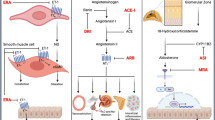Abstract
Background
Proteinuria is a dose-associated adverse event induced by anti-angiogenic agents; however, the mechanism mediating the induction of proteinuria by this type of agent remains largely unknown. The objective of this study was to assess the effects of treatment with axitinib and/or angiotensin II receptor blocker (ARB) on urinary protein excretion and renal function.
Materials and Methods
Thirty-five rats were randomly selected for treatment with following agents for 4 weeks: vehicle (group A), candesartan (group B), axitinib (group C), axitinib plus candesartan (group D), or axitinib and no treatment for subsequent 2 weeks (group E).
Results
After completion of treatment schedule, urine protein-to-creatinine ratio (UPC) in group C was significantly higher than those in groups A and B, while the additional administration of candesartan resulted in the significant reduction of UPC in group D compared with group C. Following the no treatment interval for 2 weeks, UPC in group E significantly decreased compared with that in group C. There were no significant differences in serum creatinine or blood urea nitrogen level among the five groups. Furthermore, semiquantitative evaluation of immunofluorescence findings showed that the expression levels of both nephrin and podocin in rat kidneys were inversely associated with the UPC value throughout these five groups.
Conclusions
Despite the acceleration of proteinuria involving the downregulation of slit diaphragm-associated proteins, axitinib may not have an adverse impact on renal function, and axitinib-induced proteinuria can be partially prevented by additional treatment with ARB and reversibly recovered by its transient dose-interruption.





Similar content being viewed by others
References
Figlin R, Sternberg C, Wood CG (2012) Novel agents and approaches for advanced renal cell carcinoma. J Urol 188:707–15
Hu-Lowe DD, Zou HY, Grazzini ML et al (2008) Nonclinical antiangiogenesis and antitumor activities of axitinib (AG-013736), an oral, potent, and selective inhibitor of vascular endothelial growth factor receptor tyrosine kinases 1, 2, 3. Clin Cancer Res 14:7272–83
Rini BI, Escudier B, Tomczak P et al (2011) Comparative effectiveness of axitinib versus sorafenib in advanced renal cell carcinoma (AXIS): a randomised phase 3 trial. Lancet 378:1931–9
Su D, Stamatakis L, Singer EA, Srinivasan R (2014) Renal cell carcinoma: molecular biology and targeted therapy. Curr Opin Oncol 26:321–7
Cohen RB, Oudard S (2012) Antiangiogenic therapy for advanced renal cell carcinoma: management of treatment-related toxicities. Investig New Drugs 30:2066–79
Izzedine H, Massard C, Spano JP, Goldwasser F, Khayat D, Soria JC (2010) VEGF signalling inhibition-induced proteinuria: Mechanisms, significance and management. Eur J Cancer 46:439–48
Yang JC, Haworth L, Sherry RM et al (2003) A randomized trial of bevacizumab, an anti-vascular endothelial growth factor antibody, for metastatic renal cancer. N Engl J Med 349:427–34
Hayman SR, Leung N, Grande JP, Garovic VD (2012) VEGF inhibition, hypertension, and renal toxicity. Curr Oncol Rep 14:285–94
Chiba K, Yamaguchi K, Ando M, Miyake H, Fujisawa M (2012) Expression pattern of testicular claudin-11 in infertile men. Urology 80:1161.e13–7
Macconi D, Bonomelli M, Benigni A (2006) Pathophysiologic implications of reduced podocyte number in a rat model of progressive glomerular injury. Am J Pathol 168:42–54
Bo CJ, Chen B, Jia RP et al (2013) Effects of Ischemic Preconditioning in the Late Phase on Homing of Endothelial Progenitor Cells in Renal Ischemia/Reperfusion Injury. Transplant Proc 45(2):511–6
Schrijvers BF, Flyvbjerg A, De Vriese AS (2004) The role of vascular endothelial growth factor (VEGF) in renal pathophysiology. Kidney Int 65:2003–17
de Zeeuw D, Remuzzi G, Parving HH et al (2004) Proteinuria, a target for renoprotection in patients with type 2 diabetic nephropathy: lessons from RENAAL. Kidney Int 65:2309–20
Dincer M, Altundag K (2006) Angiotensin-converting enzyme inhibitors for bevacizumab-induced hypertension. Ann Pharmacother 40:2278–9
Birn H, Christensen EI (2006) Renal albumin absorption in physiology and pathology. Kidney Int 69:440–9
Miyake H, Harada KI, Imai S, Miyazaki A, Fujisawa M (2015) Non-significant impact of proteinuria on renal function in Japanese patients with metastatic renal cell carcinoma treated with axitinib. Int J Clin Oncol 20:796–801
Schwarz K, Simons M, Reiser J et al (2001) Podocin, a raft-associated component of the glomerular slit diaphragm, interacts with CD2AP and nephrin. J Clin Invest 108:1621–9
Huber TB, Schermer B, Muller RU et al (2006) Podocin and MEC-2 bind cholesterol to regulate the activity of associated ion channels. Proc Natl Acad Sci U S A 103:17079–86
Garovic VD, Wagner SJ, Petrovic LM et al (2007) Glomerular expression of nephrin and synaptopodin, but not podocin, is decreased in kidney sections from women with preeclampsia. Nephrol Dial Transplant 22:1136–43
Eremina V, Quaggin SE (2010) Biology of anti-angiogenic therapy-induced thrombotic microangiopathy. Semin Nephrol 30:582–90
Zhao N, Xu Q, Wang M et al (2014) Mechanism of kidney injury caused by bevacizumab in rats. Int J Clin Exp Pathol 7:8675–83
Author information
Authors and Affiliations
Corresponding author
Ethics declarations
ᅟ
Ethical Approval
All applicable international, national, and/or institutional guidelines for the care and use of animals were followed, and the studies have been approved by a research ethics committee at the institution or practice at which the studies were conducted (where such a committee exists).
Funding Sources
None.
Conflict of Interest
Satoshi Imai, Hideaki Miyake, and Masato Fujisawa have no conflicts of interest to declare and did not receive any financial support.
Rights and permissions
About this article
Cite this article
Imai, S., Miyake, H. & Fujisawa, M. Acceleration of Proteinuria without Significant Impact on Renal Function and Its Protection by Angiotensin II Receptor Blocker in Rats Treated with Axitinib. Targ Oncol 11, 309–315 (2016). https://doi.org/10.1007/s11523-015-0393-6
Published:
Issue Date:
DOI: https://doi.org/10.1007/s11523-015-0393-6




